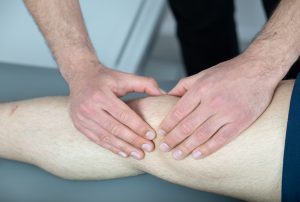 Recently, a football player sought help a few days after sustaining a thigh injury during a match. Two days after the injury, the front muscle of the thigh was painful and slightly swollen when a rough massage was performed at the club, colloquially called “breaking up the hematoma.” The day after the massage, the thigh swelling increased, leading to the hematoma being drained via puncture.
Recently, a football player sought help a few days after sustaining a thigh injury during a match. Two days after the injury, the front muscle of the thigh was painful and slightly swollen when a rough massage was performed at the club, colloquially called “breaking up the hematoma.” The day after the massage, the thigh swelling increased, leading to the hematoma being drained via puncture.
During an examination in our clinic, an ultrasound revealed a significant muscle rupture accompanied by swelling. Such injuries typically require several weeks of rest from sports activities, along with appropriate physiotherapy.
But what about the “breaking up the hematoma” technique? This concept is very old and has been part of sports physiotherapy since the field’s inception. The logic behind this therapy is that the local hematoma (blood trapped in the tissue as a result of a ruptured or contused blood vessel) should be encouraged to spread over a larger area to facilitate easier resorption. This rationale is rooted in physiology, and when done correctly, it can significantly reduce overall recovery time and speed up the return to sports. The issue lies in the timing and intensity of such a massage.
To ensure that the injured blood vessel has healed, time is needed—at least 48, preferably 72 hours after the injury. If the blood vessel hasn’t healed, any massage, especially a rough one, can trigger further bleeding, increase the hematoma, and worsen the injury, which is likely what happened in this case.
A particularly rough massage adds further trauma to all the tissues under pressure, causing reactive swelling, even if not visible to the naked eye. Such traumatized tissues around the hematoma are less able to resorb it, simply because they are also injured and focused on their own healing.
The stimulation of post-traumatic hematoma delocalization (its spreading over a larger area) through massage and other manual techniques should be done with light to moderate pressure over a prolonged period. When performed this way, the therapy lacks a destructive component and directly reduces recovery time.
